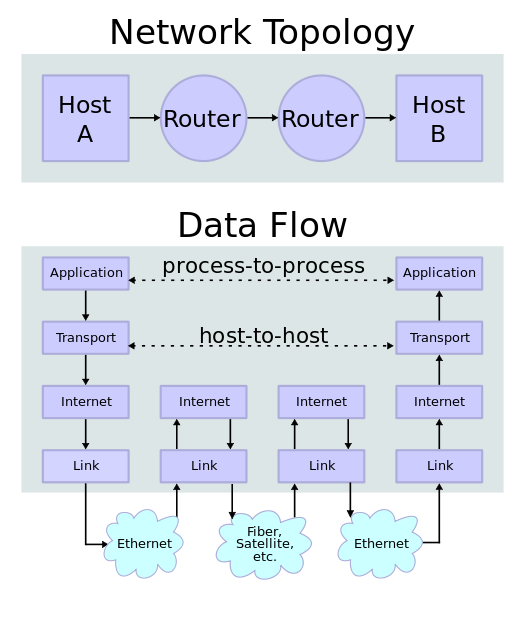Overview
Internet protocol suite is a networking model and communications protocols used by the Internet. It is commonly known as TCP/IP.
Four abstraction layers:
- Application layer
- Transport layer
- Internet layer
- Link layer

The protocols are maintained by the Internet Engineering Task Force (IETF).
A summary of four-layer model
- Application: authentication, compression, and end user services
- Transport: handles the flow of data between systems and provides access to the network for applications via the BSD socket library
- Network: packet routing
- Link: Kernel OS/device driver interface to the network interface on the computer.
More details
The Application layer:
- where applications create user data and communicate with other applications on another host (make use of Transport Layer to provide reliable or unreliable pipes to other processes).
- different application architecture, such as the client-server model and peer-to-peer.
- SMTP, FTP, SSH, HTTP all operate above this layer.
- processes are addressed via ports.

Well-known official port numbers are in the range of 0 - 255. Port 256 - 1023 are reserved for other well-known services. 1024 - 65535 are neither in-use nor reserved. They are used when TCP/IP automatically assigns port numbers to client programs.
The Transport Layer:
- performs host-to-host communications.
- “UDP” provides unreliable datagram service.
- “Transmission Control Protocol” provides flow-control, connection establishment, and reliable transmission of data.
The Internet layer:
- exchange datagrams across network boundaries.
- establishes internetworking thus establishes the Internet.
- “Internet Protocol”, defines IP addresses and the routing structures used for the TCP/IP protocol suite.
- routing: transport datagrams to the next IP router that has the connectivity to a network closer to the final data destination.
The Link layer:
- defines the networking methods within local network link without intervening routers.
- describe local network topology and the interfaces needed to effect transmission of Internet layer datagrams to next-neighbor hosts.
Difference from OSI
The Internet protocol suite was in use before the OSI model, and is well established worldwide.
The OSI model, however, is a proven concept that is used in all other data communications protocols. It will continue to be used as a guideline for all other communications applications.